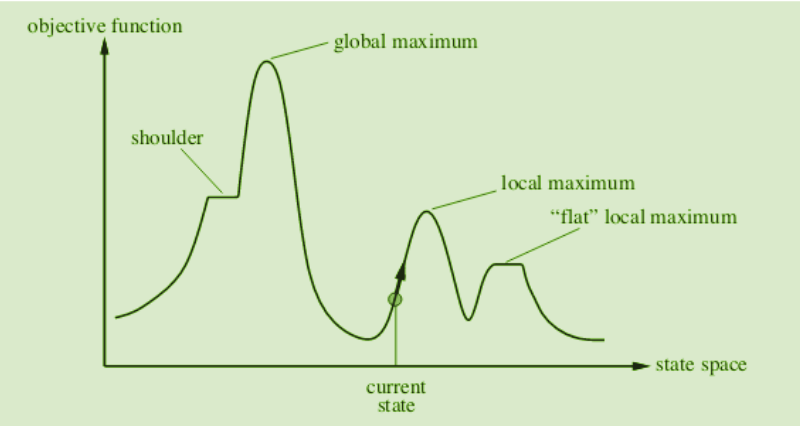- Select a state that has not been yet applied to the current state and apply it to produce a new state.
- Perform these to evaluate the new state.
- If the current state is a goal state, then stop and return success.
- If it is better than the current state, then make it the current state and proceed further.
- If it is not better than the current state, then continue in the loop until a solution is found.
2. Steepest-Ascent Hill climbing:
It first examines all the neighboring nodes and then selects the node closest to the solution state as of the next node.
Algorithm for Steepest Ascent Hill climbing :
- Evaluate the initial state. If it is a goal state then stop and return success. Otherwise, make the initial state as the current state.
- Repeat these steps until a solution is found or the current state does not change
- Select a state that has not been yet applied to the current state.
- Initialize a new ‘best state’ equal to the current state and apply it to produce a new state.
- Perform these to evaluate the new state
- If the current state is a goal state, then stop and return success.
- If it is better than the best state, then make it the best state else continue the loop with another new state.
3. Stochastic hill climbing:
It does not examine all the neighboring nodes before deciding which node to select. It just selects a neighboring node at random and decides (based on the amount of improvement in that neighbor) whether to move to that neighbor or to examine another.
- Evaluate the initial state. If it is a goal state then stop and return success. Otherwise, make the initial state the current state.
- Repeat these steps until a solution is found or the current state does not change.
- Select a state that has not been yet applied to the current state.
- Apply the successor function to the current state and generate all the neighbor states.
- Among the generated neighbor states which are better than the current state choose a state randomly (or based on some probability function).
- If the chosen state is the goal state, then return success, else make it the current state and repeat step 2 of the second point.
State Space diagram for Hill Climbing
The state-space diagram is a graphical representation of the set of states our search algorithm can reach vs the value of our objective function(the function which we wish to maximize).
- X-axis: denotes the state space ie states or configuration our algorithm may reach.
- Y-axis: denotes the values of objective function corresponding to a particular state.
The best solution will be a state space where the objective function has a maximum value(global maximum).

Different regions in the State Space Diagram:
- Local maximum: It is a state which is better than its neighboring state however there exists a state which is better than it(global maximum). This state is better because here the value of the objective function is higher than its neighbors.
- Global maximum: It is the best possible state in the state space diagram. This is because, at this stage, the objective function has the highest value.
- Plateau/flat local maximum: It is a flat region of state space where neighboring states have the same value.
- Ridge: It is a region that is higher than its neighbors but itself has a slope. It is a special kind of local maximum.
- Current state: The region of the state space diagram where we are currently present during the search.
- Shoulder: It is a plateau that has an uphill edge.
Problems in different regions in Hill climbing
Hill climbing cannot reach the optimal/best state(global maximum) if it enters any of the following regions :
- Local maximum: At a local maximum all neighboring states have a value that is worse than the current state. Since hill-climbing uses a greedy approach, it will not move to the worse state and terminate itself. The process will end even though a better solution may exist.
To overcome the local maximum problem: Utilize the backtracking technique. Maintain a list of visited states. If the search reaches an undesirable state, it can backtrack to the previous configuration and explore a new path. - Plateau: On the plateau, all neighbors have the same value. Hence, it is not possible to select the best direction.
To overcome plateaus: Make a big jump. Randomly select a state far away from the current state. Chances are that we will land in a non-plateau region. - Ridge: Any point on a ridge can look like a peak because movement in all possible directions is downward. Hence the algorithm stops when it reaches this state.
To overcome Ridge: In this kind of obstacle, use two or more rules before testing. It implies moving in several directions at once.
Here is a simple example of hill climbing in Python: